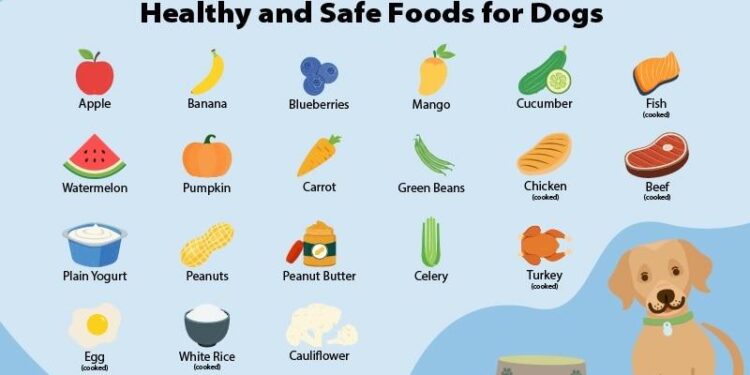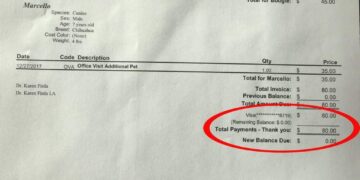Table of Contents
As a dog trainer with over a decade of experience, I thought I had seen it all.
I’ve worked with every breed, temperament, and behavioral quirk you can imagine.
My own Border Collie, Max, was my partner in this work—a brilliant, intuitive dog who was perfect in almost every Way. Except for one thing: a relentless, maddening itch that no one could solve.
It started subtly.
A little extra scratching, a head shake here and there.
We followed the vet’s advice meticulously.
We switched his food from chicken to lamb, then to fish, chasing a phantom protein allergy.
We tried hypoallergenic diets, medicated shampoos, and supplements.
Yet the problem persisted, escalating into chronic ear infections, a dull, flaky coat, and frantic, middle-of-the-night scratching sessions that left us both exhausted and heartbroken.
I felt like a failure.
Here I was, a professional who helped others solve their dogs’ problems, and I couldn’t even help my own.
The breaking point came one evening at the pet store.
Desperate, I stood before a wall of brightly colored bags, each promising a miracle.
I grabbed a package of “premium,” “vet-recommended” biscuits, swayed by the wholesome-looking pictures of vegetables and roasted meats on the front.
They were expensive, but I was willing to try anything.
Within a week, Max’s condition nosedived.
He developed a raw, weeping hot spot on his flank that required an emergency vet visit, a cone of shame, and a course of antibiotics and steroids.
That was my moment of betrayal.
Staring at my miserable dog, I realized the advice I was following, the products I was buying, and the entire system I had trusted were fundamentally broken.
A single, burning question took hold of me: If I, a dedicated professional, am this lost, how can the average dog owner possibly navigate this landscape? I decided then and there to stop being a passive consumer and start being an investigator.
My journey into the dark corners of the pet food industry began not just to heal Max, but to find an entirely new way of thinking about what we put in our dogs’ bowls.
The Illusion of Choice: Deconstructing the Modern Pet Food Aisle
My investigation started where my failure had: the pet food aisle.
At first glance, it’s a dazzling display of choice.
Bags boast of “gourmet recipes,” “ancestral diets,” and “holistic formulas.” You can find biscuits shaped like bones, stars, or little animals, in a rainbow of colors.
But as I dug deeper, a disturbing reality emerged.
This isn’t a landscape of true choice; it’s an illusion.
Behind the varied packaging, many of these products are built on the same flawed foundation of over-processing, ambiguous ingredients, and marketing designed to appeal to human sensibilities, not canine biology.
My personal struggle with Max, it turned out, was a microcosm of a nationwide epidemic of diet-related canine health issues.
The statistics are staggering.
Over half of all dogs in the United States are considered overweight or obese.1
This isn’t a cosmetic issue; it’s a gateway to a host of debilitating diseases, including diabetes, painful arthritis, high blood pressure, and even certain types of cancer.3
Pancreatitis, a potentially fatal inflammation of the pancreas, is frequently linked to diets high in poor-quality fats—the very kind found in many processed foods and table scraps.1
Other conditions, like the formation of painful bladder stones, can be triggered by the precise mineral imbalances often found in commercially formulated kibbles and treats.1
The most visible symptoms, and the ones that drove me to my breaking point with Max, are often related to the skin and immune system.
A dull, brittle coat, dry and flaky skin, and a weakened immune system are among the first signs that a dog’s body isn’t getting what it needs.4
Wounds may heal slowly, and the dog might become susceptible to recurrent infections, just like Max’s endless cycle of ear troubles.
The Allergy Maze
This led me to confront the most frustrating part of my journey: the allergy diagnosis.
Vets and pet owners alike are quick to suspect a food allergy when a dog presents with chronic itching, GI upset, or ear infections.5
And it’s true that some dogs have genuine allergies to specific proteins.
Studies show that beef is the most common culprit, affecting about 34% of dogs with food allergies, followed by dairy, chicken, and wheat.5
The standard advice is to perform an elimination diet, methodically removing potential allergens to pinpoint the trigger.
This is the path I had followed with Max, switching from chicken to lamb to fish, all to no avail.
What I came to understand is that this approach, while logical, often fails because it operates on a false premise.
We become so focused on identifying a single protein “villain” that we ignore the host of other inflammatory ingredients packed into the food.
This is how loving, dedicated owners get trapped in what I now call the “Symptom-Blame Cycle.” It works like this: You notice your dog is itching, so you blame the chicken in his food.
You switch to a new, expensive “salmon and sweet potato” formula.
But the itching continues.
Why? Because while the protein changed, the new food might still contain inflammatory vegetable oil, artificial colors known to cause hypersensitivity reactions, or even hidden, unlabeled chicken from cross-contamination during manufacturing—a surprisingly common issue.5
Now, you incorrectly conclude your dog must
also be allergic to salmon.
The confusion deepens, the frustration mounts, and the dog continues to suffer.
The problem was never just the protein.
The problem was the entire industrial philosophy behind the product.
The Epiphany: Applying the “Clean Eating” Lens to the Dog Bowl
My breakthrough didn’t come from a veterinary textbook or a pet nutrition seminar.
It came, unexpectedly, from the world of human health and wellness.
Frustrated with the dead ends in the pet world, I started reading about the history of human nutrition, and I was struck by a powerful parallel.
The modern pet food market looked exactly like the human food industry of the 1980s and 90s.
I remembered the “low-fat” craze, when grocery store shelves were filled with products stripped of fat but pumped full of sugar, refined carbohydrates, and chemical additives, all sold under a banner of “health.” The public was told that fat was the enemy, so we dutifully ate our low-fat cookies and processed snack foods, only to see rates of obesity and diabetes skyrocket.
The revolution against that flawed paradigm was a back-to-basics movement, known by various names like “clean eating” or the “whole foods” philosophy.10
The core idea was simple yet profound: focus on eating real, unprocessed foods and radically minimize anything that was refined, handled, or created in a Lab.10
It was like a lightbulb went off.
This was the answer.
I wasn’t just looking for a new ingredient; I was looking for a new philosophy.
I decided to apply this “Clean Eating for Dogs” lens to Max’s diet.
This new paradigm wasn’t a specific diet plan but a guiding philosophy built on two simple, powerful principles borrowed directly from the human wellness movement:
- The Principle of Subtraction: This is about what you don’t feed your dog. It involves a ruthless elimination of artificial, processed, and unnecessary ingredients that serve no nutritional purpose and may actively cause harm.
- The Principle of Addition: This is about what you do feed your dog. It means actively choosing treats and foods made from simple, whole, identifiable, and high-quality ingredients.
This shift in perspective was liberating.
It moved me beyond the confusing and often contradictory marketing claims of pet food companies.
I was no longer asking, “What brand is best?” which is a question that leaves you vulnerable to the next marketing fad.
Instead, I started asking, “What philosophy is best?” This new question was empowering.
It provided a durable framework for evaluating any product from any brand.
It was the key to transforming myself from a frustrated consumer into the confident Chief Nutrition Officer for my dog.
Pillar I – The Principle of Subtraction: A Guided Tour of the Ingredient Minefield
Applying the first principle of my new paradigm meant learning to read an ingredient label not as a list of nutrients, but as a potential crime scene.
I had to become an expert in identifying the fillers, chemicals, and ambiguous ingredients that had no place in a healthy dog’s diet.
This isn’t about demonizing a single ingredient in isolation; it’s about recognizing a pattern of industrial convenience that prioritizes shelf life and human appeal over canine health.
The Chemical Cocktail: Additives for Humans, Not Hounds
One of the most shocking realizations was how many ingredients are added to dog treats for purely cosmetic reasons, to appeal to the human buying the product.
Artificial Colors: Dogs possess dichromatic vision; they see a world of blues and yellows and don’t perceive the rich spectrum of reds and greens that we do.8
Those vibrant red “bacon” strips and green “minty” chews are not for your dog’s benefit—they’re for yours.
Yet these dyes are far from benign.
Common synthetic dyes like Red 40, Yellow 5, and Blue 1 are petroleum derivatives.13
While the FDA deems them safe, independent studies have linked them to hyperactivity, allergic-like hypersensitivity reactions, and even cancer in laboratory animals.8
They offer zero nutritional value and represent a completely unnecessary risk.13
Artificial Preservatives (The BHA/BHT Debate): Butylated hydroxyanisole (BHA) and butylated hydroxytoluene (BHT) are powerful antioxidants used to prevent fats in dry dog food from going rancid, dramatically extending shelf life.16
Pet food manufacturers and regulatory bodies state that they are safe at the approved levels.18
However, these are synthetic, petroleum-derived chemicals that have been questioned for their long-term safety, with some sources linking them to health problems.9
From a “Clean Eating” perspective, the debate itself is a red flag.
When effective natural alternatives like mixed tocopherols (a form of Vitamin E) and rosemary extract exist, there is no logical reason to choose the synthetic chemical version.17
The “Empty” Bulk: Fillers and Ambiguous Sources
Next, I turned my attention to the ingredients that make up the bulk of many commercial biscuits.
Fillers vs. Nutrients: Cheap commodity crops like corn, wheat, and soy are often primary ingredients in dog treats.
They are effective binders and provide a lot of calories for a low cost.4
The problem is that these are often “empty” calories.
They offer little of the high-quality protein and essential fatty acids a dog needs to thrive and can cause dangerous spikes in blood sugar.20
For dogs prone to weight gain, a diet heavy in these fillers is a direct path to obesity.4
The “Meal” and “By-Product” Mystery: This is one of the most confusing and contentious areas of pet food labeling.
According to the industry, “meat by-products” can include nutrient-rich organ meats like liver, kidneys, and spleen.21
The term “meat meal” refers to a rendered product from mammal tissues.9
While a high-quality, named meal (like “chicken meal”) can be a concentrated source of protein, the generic terms “meat meal” or “animal by-products” are enormous red flags.
The rendering process involves extreme heat that can destroy much of the nutritional value.9
Worse, the sourcing is completely opaque.
These generic terms can legally include tissues from diseased animals.19
A “Clean Eating” philosophy demands transparency.
We should be looking for identifiable, whole-food sources like “deboned chicken” or “beef liver,” not a vague, mysterious composite.
The Hidden Toxins and Inflammatory Agents
Finally, there are the ingredients that are actively harmful.
Sweeteners and Fats: Many owners know chocolate is toxic to dogs, but fewer are aware of the danger of Xylitol, an artificial sweetener found in some peanut butters, baked goods, and sugar-free products.
Even a small amount can cause a catastrophic drop in blood sugar, seizures, liver failure, and death.19
Other additives like
propylene glycol—a chemical cousin to antifreeze used to keep treats moist—have been linked to organ damage and allergic reactions.9
And while fat is a necessary part of a dog’s diet, the type matters.
Many cheap treats use
vegetable oil, which is high in omega-6 fatty acids.
An excess of omega-6s can promote inflammation throughout the body, exacerbating conditions like arthritis and skin allergies.9
To make this practical, I developed a simple checklist.
This became my tool for instantly evaluating any product on the shelf, allowing me to apply the Principle of Subtraction in seconds.
| Red Flag Category | Ingredient to Avoid (As seen on label) | The “Clean Eating” Concern |
| Artificial Colors | Red 40, Yellow 5, Yellow 6, Blue 1, Blue 2 | Purely cosmetic for the owner; linked to hyperactivity and hypersensitivity reactions.8 |
| Artificial Preservatives | BHA, BHT, Ethoxyquin, Propyl Gallate | Synthetic chemicals with potential health risks; safer, natural alternatives are readily available.17 |
| Toxic Sweeteners | Xylitol, Corn Syrup | Xylitol is lethally toxic to dogs; corn syrup provides empty calories and promotes blood sugar spikes.19 |
| Ambiguous Proteins/Fats | Meat Meal, Animal By-Products, Animal Fat | Opaque sourcing may include diseased animals; high-heat rendering destroys nutrients.9 |
| Chemical Additives | Propylene Glycol, MSG | Industrial chemicals with no nutritional purpose; linked to organ damage and allergic reactions.9 |
| Problematic Fillers | Corn, Wheat, Soy, Brewer’s Rice | Often used as cheap, low-nutrient bulk; can contribute to obesity and digestive issues.4 |
Pillar II – The Principle of Addition: Building a Foundation of Whole-Food Treats
Once I had cleared the minefield by learning what to subtract, the next step was joyful and empowering: focusing on what to add.
The “Clean Eating for Dogs” philosophy isn’t about deprivation; it’s about choosing simple, high-quality, and transparently sourced ingredients that actively build health.
The Power of Simplicity: Limited Ingredient & Single-Ingredient Treats
The most direct application of this principle led me to the world of Limited Ingredient Diets (LIDs) and single-ingredient treats.
These are not marketing fads; they are the embodiment of the “Clean Eating” philosophy.
The logic is simple: a shorter ingredient list means less opportunity for hidden allergens and inflammatory agents to cause problems.24
This makes them inherently easier to digest, which is a blessing for any dog, but especially for those with sensitive stomachs.25
Their greatest power, however, lies in their ability to break the “Symptom-Blame Cycle.” When you give your dog a treat made from just one thing—say, a piece of dehydrated beef liver—you have eliminated every other variable.
If the dog has a negative reaction, you have a clear and immediate answer.
If they do well, you have identified a “safe” food with 100% certainty.
This simple process turns a frustrating guessing game into a straightforward investigation.
This approach also fundamentally shifts the focus from quantity to quality.
Instead of a long list of cheap fillers and synthetic additives, you get a single, nutrient-dense ingredient.24
This philosophy became my new gold standard.
Defining Quality: Decoding “Human-Grade” and “Natural”
Of course, the quality of that single ingredient matters immensely.
This forced me to cut through more marketing jargon.
The term “natural” on a pet food label, while appealing, has a very loose definition from the Association of American Feed Control Officials (AAFCO) and can be used in misleading ways.26
The term “human-grade,” however, is far more meaningful.
For a product to legally use this label, every single ingredient must be edible for humans, and the entire product must be manufactured, packaged, and stored in a facility licensed for producing human food.26
This is a rigorous standard that speaks volumes about sourcing, safety, and quality control.
It is a powerful proxy for trust and aligns perfectly with the “Clean Eating” paradigm.
The first ingredient on any treat label should always be a recognizable, whole protein source like “chicken,” “beef,” or “salmon”.28
This should be non-negotiable.
Beyond that, other wholesome, simple additions can provide flavor and nutrients without complexity.
Things like pumpkin puree (great for digestion), sweet potato, applesauce, and whole-grain flours like oat or chickpea flour are excellent components of a clean biscuit.30
Simplicity doesn’t have to mean boring.
This journey revealed something profound.
Limited ingredient treats aren’t just a type of food; they are a powerful diagnostic tool.
The standard veterinary approach to diagnosing food allergies involves a strict, 8-to-12-week elimination trial using an expensive prescription diet.5
It’s a difficult and often inconclusive process, and other methods like blood and skin tests for food allergies are known to be unreliable.32
This leaves most owners in a state of expensive limbo.
The LID approach democratizes this process.
By systematically introducing single-ingredient treats—one week, just dehydrated duck; the next, just dehydrated salmon—an owner can become a detective in their own dog’s health.
You can pinpoint sensitivities with a high degree of accuracy, at a fraction of the cost and frustration of the traditional route.
This reframes these products from being just “food” to being a “method of investigation,” putting the power to solve the puzzle directly into the hands of the person who cares most.
The Actionable Framework: Becoming Your Dog’s Chief Nutrition Officer
My investigation had given me a new philosophy.
My experience with Max had proven its power.
The final step was to synthesize everything into a practical toolkit that any dog owner could use to transform their own approach to buying treats.
This is how you go from being a passive consumer to your dog’s active and empowered Chief Nutrition Officer.
The 5-Second Label Test
You can apply the entire “Clean Eating for Dogs” paradigm in the pet store aisle in less time than it takes to read the marketing claims on the front of the bag.
- Flip the Bag: Always ignore the front. The beautiful pictures and buzzwords are marketing. The truth is always in the fine print of the ingredient list on the back.
- Read the First Five: The first five ingredients comprise the vast majority of the product. The number one ingredient MUST be a named, whole protein (e.g., “Chicken,” not “Meat and Bone Meal”).28 If it’s not, put the bag back.
- Scan for Red Flags: Quickly run your eyes down the full list, looking for any of the items from the “Red Flag” table. Do you see BHA, BHT, Red 40, or propylene glycol? If you spot even one, the product fails the test.
- The Simplicity Rule: Is the ingredient list short, simple, and understandable? Can you pronounce most of the words and picture them as actual food?29 If it reads like a chemistry experiment, it’s not clean eating.
My Success Story: The Proof in the Paws
Armed with this new framework, I went home and purged my pantry.
I threw out every bag of colorful, complex, commercial junk.
The transformation began immediately.
I started giving Max simple, single-ingredient treats I bought from a local shop that specialized in dehydrated meats.
I switched his main food to a limited-ingredient diet from a brand I had vetted using my 5-Second Label Test.
The results were nothing short of miraculous, yet entirely logical.
Within a few weeks, the frantic, obsessive scratching began to subside.
The redness in his ears faded.
His coat, which had been dull and coarse, started to grow back with a deep, healthy luster.
He was more energetic, more playful.
He was the dog I always knew he could be.
This wasn’t a miracle cure; it was the simple, predictable outcome of removing the inflammatory burden of processed junk and replacing it with clean, species-appropriate fuel.
The itch I couldn’t scratch was finally gone.
A Curated List of “Paradigm-Approved” Options
The goal of this journey was never to find one single “best biscuit.” It was to find a framework for making good choices.
However, to help you start, here are examples of treat types and brands that exemplify the “Clean Eating for Dogs” philosophy.
This is not an exhaustive list, but a starting point for your own investigation.
- Single-Ingredient & Freeze-Dried Treats: This is the purest expression of the philosophy. They are exactly what they say they are. Look for brands that are transparent about their sourcing. The philosophies of companies like Farm to Pet and Remy’s Kitchen, which focus on human-grade, single-source proteins, are excellent examples of this category in action.29
- Limited Ingredient Biscuits: For a classic crunchy biscuit, seek out brands with short, clean ingredient lists. The first ingredient should be a whole protein, followed by simple, whole-food binders like oat flour, chickpea flour, or sweet potato. If you can’t find a brand you trust, these are also the easiest type of treat to make at home.31
- A Note on Functional Treats (Dental Health): Sometimes, you need a treat to do a specific job, like cleaning teeth. In these cases, looking for a product with the Veterinary Oral Health Council (VOHC) Seal of Acceptance is a good start, as it indicates the product has been proven to help control plaque and/or tartar.34 Products like Greenies, OraVet Dental Hygiene Chews, and certain Purina DentaLife treats carry this seal. However, you must still apply the “Clean Eating” lens. Evaluate their ingredient lists and choose the best option available that meets both your functional goal and your new quality standards.
Conclusion: The Best Biscuit is a Philosophy
I began this journey looking for a product.
I ended it with a philosophy.
The most important lesson I learned is that the best biscuit isn’t a specific brand you can buy off a shelf.
The best biscuit is one that is chosen with knowledge, care, and a clear understanding of what it means to truly nourish your dog.
The pet food industry is complex and often misleading, but you do not have to be a victim of its marketing.
By embracing the simple principles of subtraction and addition—by learning to read a label, prioritize whole foods, and demand transparency—you can protect your dog from the chronic health issues that plague so many of our companions.
By becoming your dog’s Chief Nutrition Officer, you are giving them the greatest treat of all: the foundation for a long, vibrant, and deeply healthy life.
Works cited
- 5 Common Dog Illnesses that are Impacted by Nutrition | petMD …, accessed August 13, 2025, https://www.petmd.com/dog/centers/nutrition/dog-diarrhea-and-other-diseases-impacted-by-nutrition
- 10 Most Common Diet-Related Diseases in Dogs | Cola’s Kitchen Blog, accessed August 13, 2025, https://colaskitchen.com/blog-posts/10-most-common-diet-related-diseases-in-dogs
- The Role of Nutrition in Preventing and Managing Chronic Pet Diseases – Partners for Pets, accessed August 13, 2025, https://www.partnersforpetsal.com/blog/february-the-role-of-nutrition-in-preventing-and-managing-chronic-pet-diseases-a-comprehensive-guide
- 5 Common Dog Illnesses That Are Impacted by Nutrition – American …, accessed August 13, 2025, https://www.akc.org/expert-advice/health/5-common-dog-illnesses/
- Food Allergies In Dogs – Veterinary Skin & Ear, accessed August 13, 2025, https://veterinaryskinandear.com/food-allergies-in-dogs/
- How to Tell If Your Dog Has a Food Allergy | Animal Care Center of Castle Pines, accessed August 13, 2025, https://www.animalcarectr.com/blog/how-to-tell-if-your-dog-has-a-food-allergy
- Food Allergies in Pets: Signs, Common Triggers, Diagnosis & Treatment – vetderm clinic, accessed August 13, 2025, https://www.vetdermclinic.com/food-allergies-in-pets-signs-common-triggers-diagnosis-treatment/
- Food Coloring in Pet Food: What You Need to Know – Wag!, accessed August 13, 2025, https://wagwalking.com/wellness/food-coloring-in-pet-food-what-you-need-to-know
- 9 Unsafe Ingredients to Avoid in Dog Food – Natural Pet Food, accessed August 13, 2025, https://rawznaturalpetfood.com/dog-food-ingredients-to-avoid/
- memorialhermann.org, accessed August 13, 2025, https://memorialhermann.org/services/specialties/heart-and-vascular/healthy-living/nutrition/getting-started-on-clean-eating#:~:text=You%20have%20probably%20heard%20of,been%20processed%2C%20refined%20or%20handled.
- www.wholefoodsmarket.com, accessed August 13, 2025, https://www.wholefoodsmarket.com/mission-values#:~:text=Our%20purpose%20is%20to%20nourish,mind%20at%20Whole%20Foods%20Market.
- Getting Started on Clean Eating | Memorial Hermann, accessed August 13, 2025, https://memorialhermann.org/services/specialties/heart-and-vascular/healthy-living/nutrition/getting-started-on-clean-eating
- Is Food Coloring Safe For Dogs? – Dogs Naturally, accessed August 13, 2025, https://www.dogsnaturallymagazine.com/is-food-coloring-safe-for-dogs/
- The Hidden Danger of Food Coloring in Dog Treats | A PUP’S LIFE, accessed August 13, 2025, https://www.apupslifellc.com/s/stories/the-hidden-danger-of-food-coloring-in-dog-treats
- Is food coloring safe for dogs? – The Food Space – Quora, accessed August 13, 2025, https://thefoodspace.quora.com/Is-food-coloring-safe-for-dogs
- www.researchgate.net, accessed August 13, 2025, https://www.researchgate.net/publication/378697484_Beynen_AC_2024_BHA_and_BHT_in_dog_and_cat_food#:~:text=BHA%20(butylated%20hydroxyanisole)%20and%20BHT,against%20oxidation%2C%20thus%20preventing%20rancidity.
- Natural and Artificial Preservatives in Dog Food – PetMD, accessed August 13, 2025, https://www.petmd.com/blogs/nutritionnuggets/jcoates/2012/dec/natural-artificial-preservatives-in-dog-foods-29523
- BHA & BHT in Purina Pet Food, accessed August 13, 2025, https://www.purina.eu/your-questions-matter/ingredients/BHA-BHT-in-pet-food
- Ingredients to Avoid in Dog Food, Treats, and Bones – Union Lake Veterinary Hospital, accessed August 13, 2025, https://unionlakeveterinaryhospital.com/blog/ingredients-to-avoid-in-dog-food-treats-and-bones
- Safe Dog Biscuits: Ingredients to Avoid | Hill’s Pet – Hill’s Pet Nutrition, accessed August 13, 2025, https://www.hillspet.com/dog-care/nutrition-feeding/safe-dog-biscuits
- What are Animal By-Products in Dog Food? – Purina, accessed August 13, 2025, https://www.purina.com/articles/dog/health/nutrition/what-are-animal-by-product
- www.purina.com, accessed August 13, 2025, https://www.purina.com/articles/dog/health/nutrition/what-are-animal-by-product#:~:text=When%20it%20comes%20to%20wet,meal%20is%20a%20common%20ingredient.
- What Are Meat By-Products in Dog Food? | Purina US, accessed August 13, 2025, https://www.purina.com/articles/dog/health/nutrition/meat-byproducts
- Why You Should Choose Limited Ingredient Dog Treats – Earth …, accessed August 13, 2025, https://www.earthbuddypet.com/blogs/pet-care/why-choose-limited-ingredient-dog-treats
- Limited Ingredient Dog Treats: A Healthy Choice for Your Pet – Talis Us, accessed August 13, 2025, https://talis-us.com/blogs/news/limited-ingredient-dog-treats-a-healthy-choice-for-your-pet
- Human-Grade Dog Food: What Does It Mean? – Petco, accessed August 13, 2025, https://www.petco.com/content/content-hub/home/articlePages/food-nutrition/what-is-human-grade-dog-food—what-does-it-mean-.html
- Human Grade Dog Treats from The Dog Chef, accessed August 13, 2025, https://www.thedogchef.co.uk/dog-treats/human-grade-dog-treats/
- 13 Best Dog Treats in 2025, Recommended by Vets | PetMD, accessed August 13, 2025, https://www.petmd.com/dog/vet-verified/best-dog-treats
- Vet-Recommended Dog Treats: What Makes Them Safer and Healthier? – Remy’s Kitchen, accessed August 13, 2025, https://remysk9kitchen.com/vet-recommended-dog-treats-what-makes-them-safer-and-healthier/
- Dog Treat Ingredients: A (Doggy) Chef’s Guide, accessed August 13, 2025, https://www.wiggleworthy.com/dog-treat-ingredients.html
- Homemade Dog Treats Recipe – Peanut Butter Dog Treats – The Cookie Rookie, accessed August 13, 2025, https://www.thecookierookie.com/pb-dog-treats/
- Common Signs of a Food Allergy in Pets – Anicira, accessed August 13, 2025, https://anicira.org/resources/common-signs-of-a-food-allergy-in-pets/
- Are Single-Ingredient Dog Treats the Best Healthy Dog Treat …, accessed August 13, 2025, https://farmtopettreats.com/blogs/word-on-the-treats/single-ingredient-dog-treats
- Accepted Products – Veterinary Oral Health Council, accessed August 13, 2025, https://vohc.org/accepted-products/






